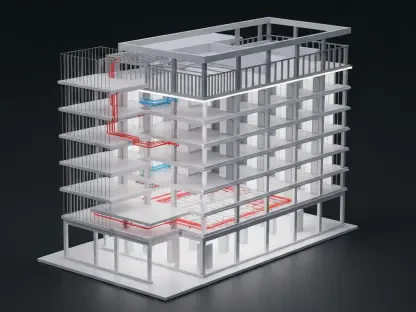John F. Kennedy International Airport (JFK) continues to lead in integrating cutting-edge technology into its operations with the launch of the Enhanced Passenger Process (EPP) at Terminal 4. This initiative, developed in collaboration with U.S. Customs and Border Protection (CBP) and BigBear.ai, marks a pivotal advancement in airport efficiency, particularly in streamlining the arrival process for U.S. citizens. With the peak summer travel season in full swing, the introduction of facial biometric technology is set to transform the passenger experience, enabling quicker and more efficient verification of identities while maintaining stringent security standards.
The Role of Facial Biometrics in Streamlining Arrivals
Automating Identity Verification and Enhancing Efficiency
Facial biometric technology represents a significant step forward in automating the identity verification process previously conducted by CBP officers. Under the traditional system, arriving passengers would present their passports and have their photographs taken manually. The EPP system now automatically handles these tasks, capturing passenger photos and rapidly cross-referencing them with existing CBP records to verify citizenship. This automation not only speeds up the arrival process but also frees up CBP officers to focus on more critical tasks, such as conducting traveler interviews and collecting customs declarations. By reallocating officer responsibilities, JFKIAT aims to enhance both efficiency and accuracy in passenger processing while upholding high security standards.
The integration of facial recognition technology is part of a broader trend across the aviation industry, where technological innovation is employed to boost operational efficiency and passenger satisfaction. Participation in the EPP at JFK Terminal 4 is voluntary, offering U.S. citizens the option to engage with this technology at no additional cost or requirement for prior enrollment. Passengers seeking to retain the conventional passport check method can still opt for a standard screening performed by a CBP officer. This dual approach ensures that the needs and preferences of all travelers are accommodated, fostering a more inclusive and versatile airport environment.
Balancing Security and Passenger Convenience
Security remains a top priority in the implementation of facial biometrics at JFK, and the system is designed to uphold stringent protocols as it enhances passenger convenience. The automated identification process is performed with precision, yet the human element is retained through officer-led interviews and customs declarations, adding an additional layer of scrutiny and security. This balanced approach reflects JFKIAT’s dedication to modernizing operations without compromising the safety and integrity of passenger information and airport facilities.
By employing facial biometric technology, JFKIAT not only streamlines operations but also sets a new standard for how technology can be used to enhance the travel experience. The efficiency gains resulting from automated processes enable travelers to spend less time in lines and more time relaxing or enjoying the amenities the terminal offers. As more airports worldwide explore similar technological advancements, JFK Terminal 4’s successful implementation of EPP is likely to become a benchmark for future innovations in airport operations and passenger processing.
JFK Terminal 4’s Broader Transformation Initiatives
Expanding Infrastructure and Technological Solutions
The introduction of EPP at JFK Terminal 4 is a strategic component of a larger transformation initiative for the terminal and the broader airport infrastructure. This multi-billion-dollar investment strategy encompasses both traditional infrastructural enhancements and the integration of advanced technology to accommodate increased passenger volume and improve the overall travel experience. In 2024, Terminal 4 experienced a record 27.7 million passengers, underscoring the critical need for such modernization efforts to ensure smooth and efficient operations.
Beyond the EPP, JFKIAT is pursuing a variety of projects designed to optimize terminal operations. These include increasing staffing levels to handle higher passenger volumes, implementing mobile passport control options, and exploring other state-of-the-art technology solutions. Each of these measures aims to minimize wait times, streamline passenger movement through the terminal, and provide more convenient and sustainable travel experiences. By adopting a comprehensive approach to terminal upgrades, JFKIAT positions itself as a leader in the aviation industry’s ongoing quest for innovation and improvement.
Innovative Collaborations and Future Prospects
Collaboration between JFKIAT, governmental agencies, and technology partners is central to the terminal’s transformation strategy. A noteworthy example is the partnership with Volan to introduce a cart service, enhancing passenger mobility within the terminal. Additionally, dynamic digital signage is being installed to improve wayfinding and ensure passengers are informed and guided effectively throughout their journey. As these collaborative efforts unfold, Terminal 4 is better prepared to meet the needs of aviation customers, offering a seamless and pleasant travel experience that combines cutting-edge technology with strategic infrastructure advancements.
Looking ahead, JFK Terminal 4’s modernization is part of the Port Authority of New York & New Jersey’s comprehensive $30 billion investment plan to revamp airport facilities across the state, with a notable $19 billion allocation for JFK alone. Aviation Director Sarah McKeon has emphasized the role smart technologies and strategic partnerships will play in enhancing airport operations and delivering a world-class customer experience. By striking a delicate balance between efficiency and security, these investments present promising opportunities for JFK Terminal 4 to continue setting new benchmarks in the aviation sector.
Shaping the Future of Air Travel
Setting a Standard for Modern Airport Operations
The introduction of EPP at JFK Terminal 4 marks a shift in airport operations towards a more modern, technology-driven approach that efficiently serves the needs of both travelers and staff. As the aviation sector evolves, leveraging biometric systems like facial recognition technology will undoubtedly become instrumental in optimizing operational processes and enhancing security measures. The voluntary nature of participating in the EPP, alongside options for traditional screening, demonstrates a commitment to inclusivity and flexibility in passenger services, recognizing diverse traveler preferences and requirements.
The continued development of JFK Terminal 4 emphasizes the importance of investing in infrastructure and technology to meet the demands of modern air travel. As JFKIAT works to navigate the challenges of today’s aviation industry, the steps taken to modernize Terminal 4 contribute not only to improved passenger experiences but also to setting a precedent for other airports to emulate. The successful execution of these projects holds promise for a future where seamless, secure, and efficient airport operations become standard practice globally.
Future Outlook on Passenger Processing
John F. Kennedy International Airport (JFK) sets the pace in adopting innovative technology with the debut of the Enhanced Passenger Process (EPP) in Terminal 4. This groundbreaking system, created in partnership with U.S. Customs and Border Protection (CBP) and BigBear.ai, represents a significant leap forward in boosting airport efficiency. Specifically designed to enhance the arrival experience for U.S. citizens, this technology promises to streamline operations considerably. As the peak summer travel season unfolds, the introduction of facial biometric technology is expected to revolutionize how passengers experience their journey. By allowing more expedient and effective identity verification, this system maintains high security while ensuring smooth travel. The use of facial recognition technology not only reduces wait times but also increases accuracy, paving the way for a seamless travel experience. This initiative is poised to set a new standard in airport operations, aligning technological advancements with passenger convenience and robust security measures.









